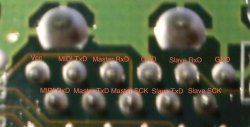mrkotfw
Mid Boss
antime said:Looking at the bottom of the Saturn mainboard, the link port's pinout is
Code:Vcc Midi RxD Midi TxD Master TxD Master RxD Master SCK GND Slave TxD Slave RxD Slave SCK GND
I just soldered wires directly to the corresponding TxD/RxD/SCK pins of a DLP-2232M module. Unfortunately the FT2232 IC uses incompatible pinouts in asynchronous and synchronous serial modes, so you have to decide which one you want to use on channel A. I used synchronous mode because of the faster transfer speed (~1.2Mbit/s vs. ~224Kbit/s), but async is a lot easier to work with.
I'm looking at the data sheet and TXD and RXD (can't find SCK. Is that some clock signal?). TXD and RXD correspond to pin 40 and 39, respectively for channel A. But the description states that it's asynchronous transfer.
But those pin names are for 232 UART mode? I'm unsure on whether I need to change the operating mode.
Also in your pinout of the bottom of the Saturn mainboard, is VCC pin 1, Midi RxD pin 2, and so on?



